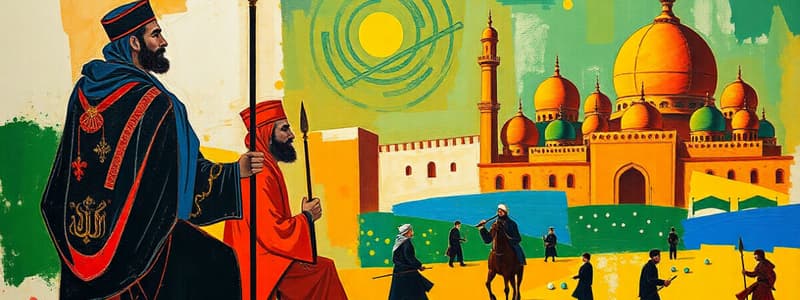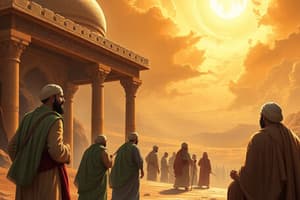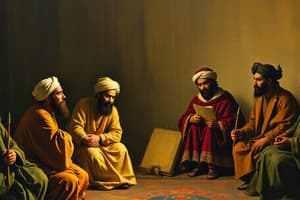Podcast
Questions and Answers
What event triggered the Mongol invasion of the Khwarazmian Empire?
What event triggered the Mongol invasion of the Khwarazmian Empire?
The murder of Mongol merchants.
Which dynasty was defeated by Hulagu Khan which ended the Islamic Golden Age?
Which dynasty was defeated by Hulagu Khan which ended the Islamic Golden Age?
The Abbasid Caliphate.
What major empires bordered the Arabian Peninsula before the rise of Islam in the 6th century?
What major empires bordered the Arabian Peninsula before the rise of Islam in the 6th century?
The Sasanian Empire to the east and the Byzantine Empire to the west.
What was the significance of the Battle of Ain Jalut in 1260?
What was the significance of the Battle of Ain Jalut in 1260?
Who was the founder of the Ottoman Empire and where did he establish his principality?
Who was the founder of the Ottoman Empire and where did he establish his principality?
What is the significance of the Hijra in Islamic history?
What is the significance of the Hijra in Islamic history?
What was the immediate result of the Ottoman conquest of Constantinople?
What was the immediate result of the Ottoman conquest of Constantinople?
What was the major religious difference between the Shia and Sunni Muslims?
What was the major religious difference between the Shia and Sunni Muslims?
Name one major contribution to Islamic architecture or culture created during the Umayyad Caliphate?
Name one major contribution to Islamic architecture or culture created during the Umayyad Caliphate?
What two other Islamic empires emerged to the east of the Ottoman Empire in the 16th century?
What two other Islamic empires emerged to the east of the Ottoman Empire in the 16th century?
What marked the Golden Age of Islamic civilization during the Abbasid Caliphate?
What marked the Golden Age of Islamic civilization during the Abbasid Caliphate?
What was the lasting significance of the Ottoman Empire in Islamic history?
What was the lasting significance of the Ottoman Empire in Islamic history?
What new title did the Seljuk Turks adopt, and why was it significant?
What new title did the Seljuk Turks adopt, and why was it significant?
What was the primary goal of the Crusades launched by European Christians?
What was the primary goal of the Crusades launched by European Christians?
Which Muslim leader defeated the Crusaders and liberated Jerusalem?
Which Muslim leader defeated the Crusaders and liberated Jerusalem?
Flashcards
Ottoman Empire
Ottoman Empire
A powerful empire founded by the Turkic, Muslim leader Osman in Anatolia around 1300 CE. It rose to prominence by challenging the Byzantine Empire. The Ottomans conquered territories in Анатолии and the Balkans, leading to the capture of Constantinople in 1453 CE.
Mongol Conquest
Mongol Conquest
The Mongols, led by Genghis Khan, conquered vast territories including Iran, the Caucasus, and Anatolia in the 13th century. The Mongols destroyed the Khwarazmian Empire after a bloodbath triggered by the Mongols murdering Khwarazmian merchants.
Mamluk Sultanate
Mamluk Sultanate
The Mamluks, a group of Turkic slave-soldiers who initially served Muslim rulers, eventually gained political power in Egypt. Their significance lies in stopping the Mongol expansion at the Battle of Ain Jalut in 1260 CE.
Fall of the Abbasid Caliphate
Fall of the Abbasid Caliphate
Signup and view all the flashcards
Ilkhanid Dynasty
Ilkhanid Dynasty
Signup and view all the flashcards
Timur's Empire
Timur's Empire
Signup and view all the flashcards
Gunpowder Empires
Gunpowder Empires
Signup and view all the flashcards
The Rise of Islam
The Rise of Islam
Signup and view all the flashcards
What was the Rashidun Caliphate?
What was the Rashidun Caliphate?
Signup and view all the flashcards
Shia Islam
Shia Islam
Signup and view all the flashcards
Sunni Islam
Sunni Islam
Signup and view all the flashcards
The Umayyad Caliphate
The Umayyad Caliphate
Signup and view all the flashcards
The Abbasid Caliphate
The Abbasid Caliphate
Signup and view all the flashcards
The Seljuk Empire
The Seljuk Empire
Signup and view all the flashcards
Saladin and the Ayyubid Dynasty
Saladin and the Ayyubid Dynasty
Signup and view all the flashcards
Study Notes
The Arabian Peninsula before Islam
- The 6th century Arabian Peninsula was bordered by the Sasanian Empire (east) and the Byzantine Empire (west)
- Arab inhabitants were largely nomadic.
- Most Arabs practiced polytheism.
The Rise of Islam
- Muhammad, born in Mecca around 570 CE, was a prophet of Islam.
- Muhammad preached Islamic monotheism.
- The Quran was revealed to Muhammad and compiled into Islam's holy book.
- Facing persecution in Mecca, Muhammad migrated to Medina; this migration marks the start of the Islamic calendar.
- Muhammad united Arab tribes into a single Muslim nation.
- Muhammad's death in 632 CE led to succession disputes and the formation of the Caliphate.
Rashidun Caliphate
- The first four caliphs, known as "Rightly Guided Caliphs," were selected based on their connection to Muhammad and respected qualities.
- The Rashidun Caliphate (632-661 CE) created the first Islamic state with governance structures, taxes, and a bureaucracy.
- The Rashidun Caliphate expanded rapidly, from Iran to North Africa.
- The Rashidun era is considered the Golden Age of Islam.
- Internal strife and assassinations marked the Rashidun Caliphate.
Shia Islam
- Supporters of Ali ibn Abi Talib, Muhammad's cousin and son-in-law, believed he should have been the first Caliph.
- Shias believe that Ali and his descendants are the only legitimate rulers.
Sunni Islam
- Opposing Ali's claim to the Caliphate, Sunnis rejected Ali's direct succession.
- The split between Shia and Sunni Islam represents a major religious division within Islam.
Umayyad Caliphate
- The Umayyad family, establishing themselves in Syria, gained power in 661 CE, ruling for 90 years.
- The Umayyad Caliphate made Damascus its capital.
- The Umayyads established a dynastic system of succession, passing the Caliphate from father to son.
- Umayyad conquests spanned from Central Asia to the Iberian Peninsula.
- Umayyad expansion ended in the west at the Battle of Tours against Frankish forces.
- Caliph Abd al-Malik centralized authority, highlighted Arab identity, and oversaw projects like the Dome of the Rock.
- Internal struggles and revolts led to the Umayyads' demise.
Abbasid Caliphate
- The Abbasid dynasty (750-1258 CE) replaced the Umayyad Caliphate.
- Abbasids, a Sunni Arab family tracing lineage to Muhammad's uncle Abbas, rose to power.
- The Abbasid Caliphate moved its capital from Damascus to Baghdad, making it the world's largest and most prosperous city.
- The Abbasid era is considered a Golden Age of Islamic civilization, recognized for scholastic pursuits, translations, and original research.
- Caliph Harun al-Rashid (known from "Arabian Nights") supported scholars, maintained diplomatic ties with Charlemagne, and even sent an elephant to Europe.
- From the mid-9th century, the Abbasids lost control to local Muslim dynasties.
- The Abbasid Caliph became a largely ceremonial figure.
- Persian and Turkic influences grew within the Caliphate, diminishing the emphasis on purely Arab identity.
Islamic Presence in Iberia
- The Umayyad dynasty's rule in Iberia continued for centuries after their loss of control in the Middle East.
- The Christian Reconquista gradually reclaimed territories in Spain from Islamic rule.
Persian Dynasties
- The Abbasids faced opposition from various Persian dynasties.
- These dynasties fostered a revival of Persian culture and language.
- The Buyid family seized control of Baghdad in 945 CE, limiting Abbasid power.
- The Buyids ruled a confederation encompassing Iraq and western Iran.
Fatimid Caliphate
- The Fatimids, an ambitious Arab Shia dynasty claiming descent from Muhammad's daughter Fatima, rose in North Africa.
- The Fatimids established Cairo as their capital.
- They sought to overthrow the Abbasid Caliphate, achieving a "shadow-caliphate" status for approximately 200 years..
Rise of Shia Islam
- Shia Islam emerged as a distinct religious tradition in the early 10th century, influenced by political successes of Shia dynasties like the Fatimids and Buyids.
Turkic Migrations
- Turkic tribes migrated from Central Asia to the Middle East, converting to Sunni Islam and integrating into the Islamic landscape.
- The Seljuks, a Sunni Turkic family, captured Baghdad in 1055 CE.
- The Seljuks adopted the title of Sultan.
- The Seljuk Empire encompassed vast regions, but didn't dethrone the Abbasid Caliph.
- The Seljuks defended the Abbasid Caliphate against the Shia Fatimids.
- The Seljuks' victory at the Battle of Manzikert (1071 CE) opened Anatolia to Turkic tribes, initiating the transition from a Greek-Christian region to one dominated by Turkic Muslims.
- The Sultanate of Rum, a Seljuk branch, became the most significant political power in Anatolia; from this, modern Turkey emerged.
The Crusades
- Beginning in 1095 CE, the Crusades were European Christian military expeditions seeking control of holy sites from Muslim rule.
- European forces occupied Jerusalem and established states along the Mediterranean coast.
- The Crusades spanned nearly 200 years.
- Muslims viewed Crusaders as representatives of a culturally inferior civilization.
Saladin and the Ayyubid Dynasty
- Saladin, a prominent Kurdish Sunni leader, rose to power in the 12th century.
- Saladin defeated the Fatimids and established the Ayyubid dynasty, governing Egypt and Syria.
- Saladin's victory at the Battle of Hattin (1187 CE) led to the recapture of Jerusalem and greatly weakened the Crusaders.
Khwarazmian Empire
- Emerged in the 12th century, the Khwarazmian Empire, previously a Seljuk vassal, controlled Iran and parts of Central Asia.
Mongol Invasions
- Genghis Khan unified the Mongols forming the largest contiguous land empire in history.
- The Mongol Empire conquered extensive territories, including Iran, the Caucasus, and Anatolia.
- Mongol merchants' deaths in the Khwarazmian Empire sparked a devastating conflict, destroying the empire.
- Hulagu Khan (Genghis Khan's grandson) assaulted Baghdad in 1258, wrecking the city and slaughtering its inhabitants.
- The Abbasid Caliphate was destroyed, marking the end of the Islamic Golden Age.
- The Abbasid Caliph met a violent end, trampled by horses.
- Hulagu Khan's conquests extended to Egypt, where he confronted the Ayyubid dynasty.
Mamluk Sultanate
- The Mamluks, Turkic slave-soldiers, rose to power in Egypt.
- Mamluks played a crucial role in stopping the Mongol advance.
- The Mamluks defeated the Mongols at the Battle of Ain Jalut (1260 CE), halting their expansion.
- Mamluk Sultan Baibars subjugated the Crusaders, contributing to their ultimate collapse.
- The Mamluks are seen as defenders of Islam, re-establishing the Abbasid Caliphate in Cairo.
- The Mamluks ruled Egypt for approximately 250 years.
Mongol Successors
- After Genghis Khan's death, the vast Mongol Empire fractured into regional dynasties.
- Many Mongols converted to Islam and adopted Turkish languages.
- The Ilkhanid dynasty, deriving from Hulagu, controlled territories spanning from Anatolia to Iran.
- The Ilkhanids displayed both brutality and contributions to culture.
Timur/Tamerlane
- Timur, a Turco-Mongol conqueror, emerged after the Ilkhanate's collapse in the 14th century, forging a new empire.
- Timur's empire expanded across vast lands, characterized by both cruelty and cultural accomplishments.
- Timur's empire lasted well into the 15th century.
Rise of the Ottoman Empire
- Osman, a Turkic-Muslim leader, emerged around 1300 CE, eventually creating the Ottoman Empire through conquest of Byzantine territories in Anatolia and the Balkans.
- In 1453 CE, the Ottomans conquered Constantinople, ending Byzantine rule of a thousand years.
- Constantinople (Istanbul) transitioned to the Ottoman capital.
- Sultan Selim the Grim dramatically expanded the empire using gunpowder technology, tripling its size.
- Ottoman expansion encompassed the Middle East, North Africa, and Southeastern Europe.
- Selim conquered Cairo in 1517 CE, eliminating Mamluk rule and the Abbasid Caliphate in Cairo.
- Selim declared himself Caliph, claiming leadership of Sunni Islam.
Other Islamic Gunpowder Empires
- In the 16th century, other Islamic empires arose east of the Ottoman Empire:
- The Shia Safavid Empire developed as the foundation of modern Iran.
- The Mughal Empire governed India.
- These three empires, called the "Gunpowder Empires," held significant power.
Fall of the Ottoman Empire
- The Ottoman Empire, the final Islamic Caliphate, lasted nearly 600 years before collapsing after World War I in the 20th century.
Studying That Suits You
Use AI to generate personalized quizzes and flashcards to suit your learning preferences.




